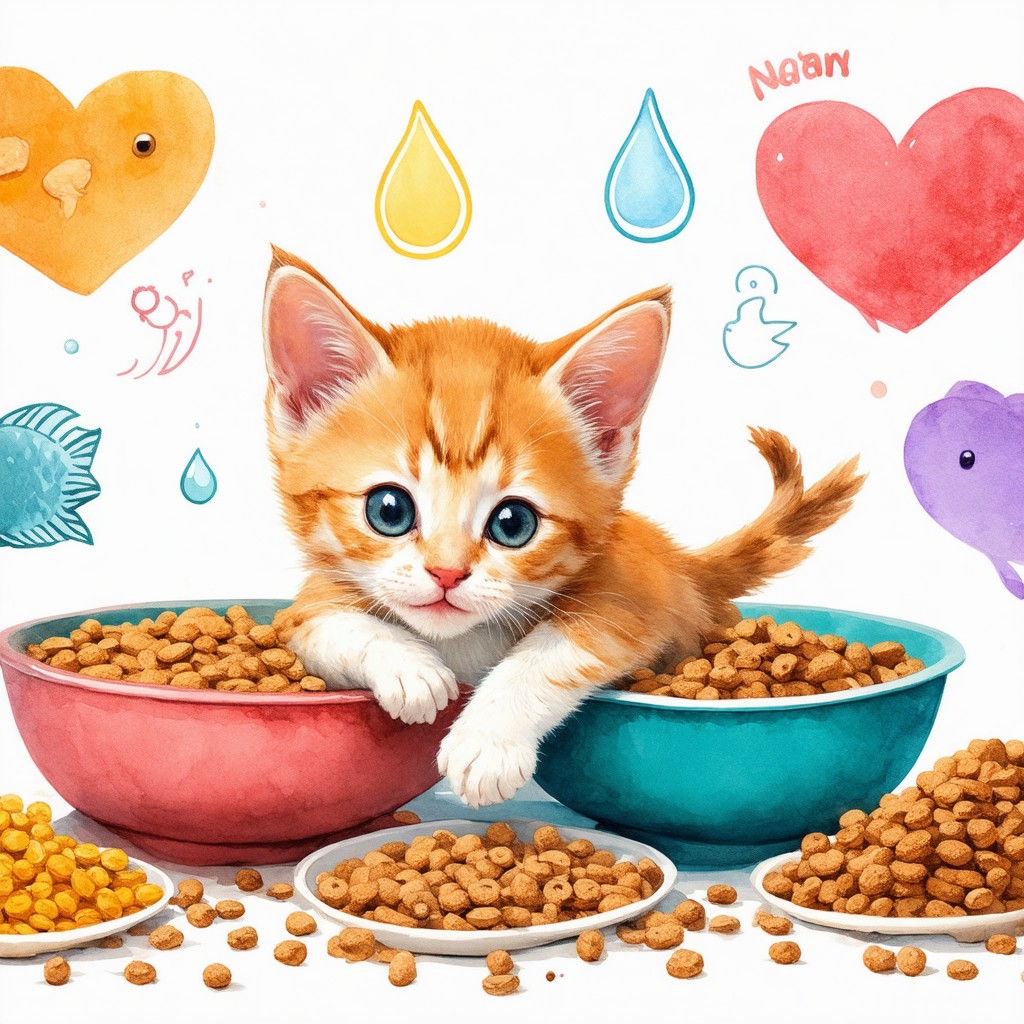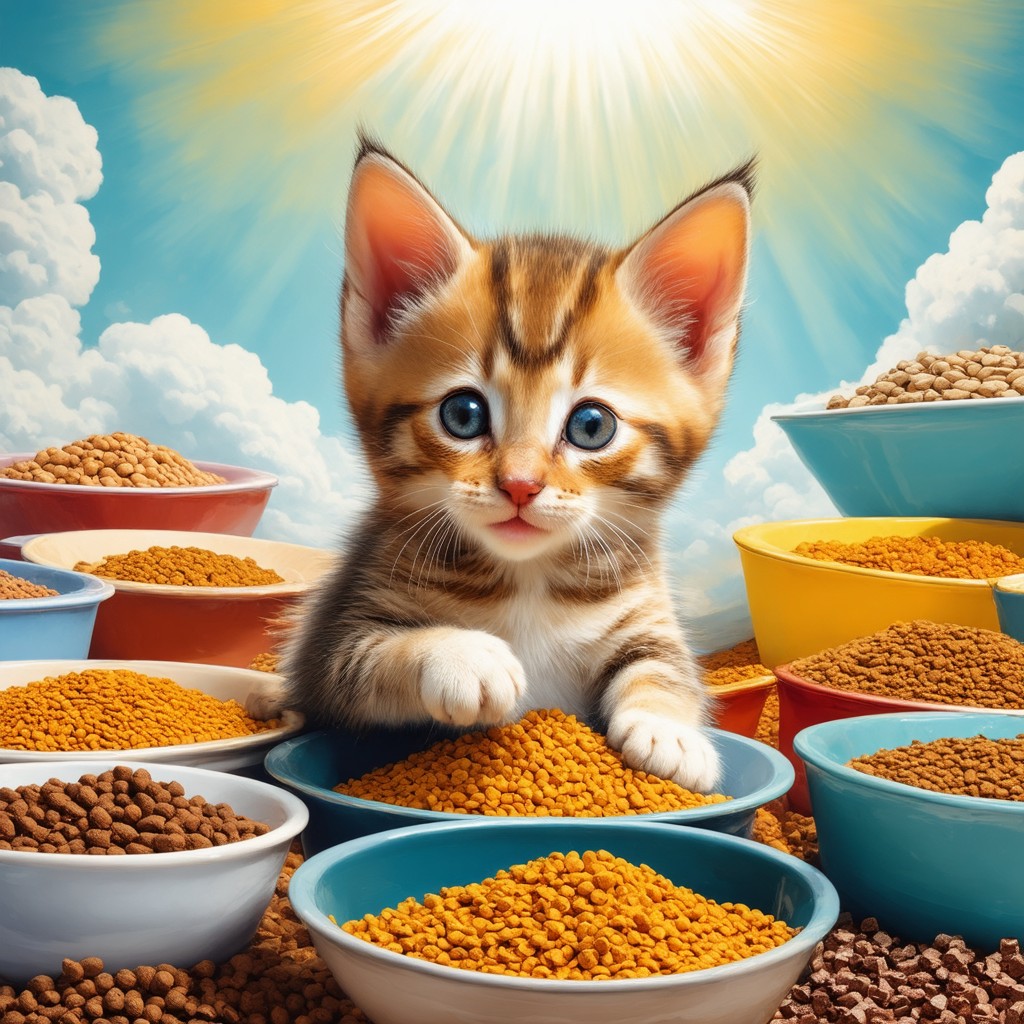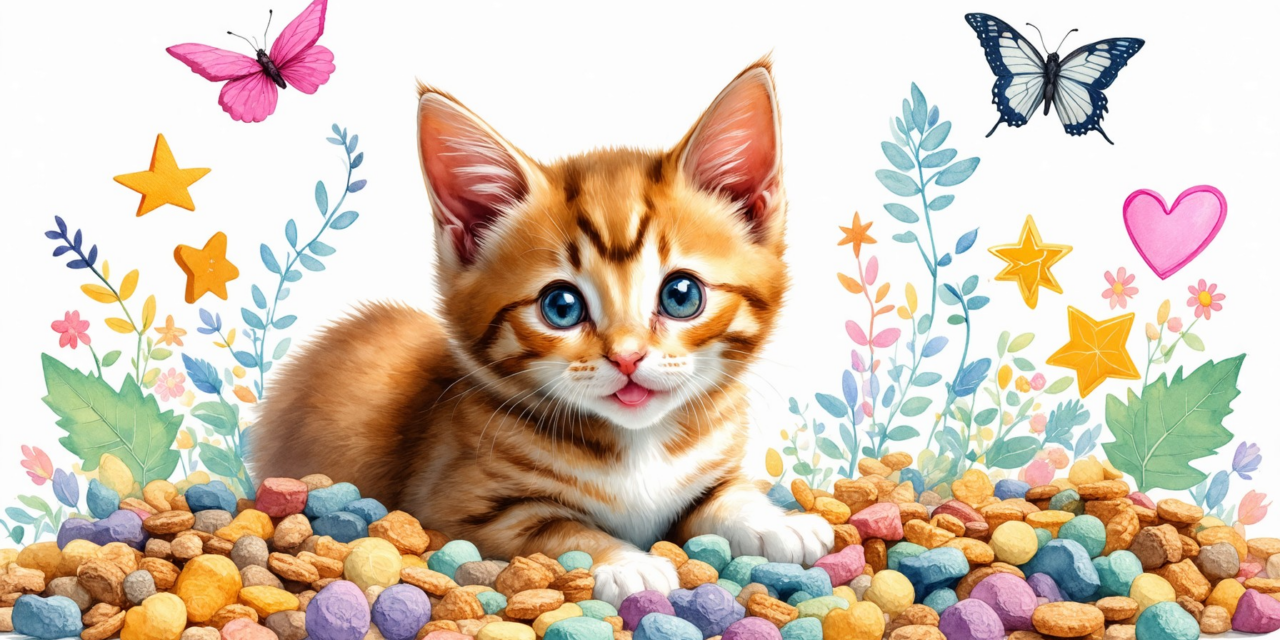Key Takeaways
- Balanced Diet: Kittens need a mix of wet and dry food for optimal growth and hydration.
- Feeding Schedule: Establish a routine of three to four meals daily until six months old, then transition to two meals.
- Quality Matters: Choose high-quality kitten dry food with real meat as the first ingredient and essential nutrients for development.
- Gradual Transition: When moving from wet to dry food, do so gradually to prevent digestive upset.
- Veterinary Guidance: Always consult a veterinarian for personalized feeding recommendations tailored to your kitten’s health.
Choosing the right kitten dry food is crucial for your feline’s growth and development. As a responsible pet owner, understanding the nutritional needs of your kitten is essential, especially when navigating the transition from wet to dry food. In this article, we will explore key topics such as how long kittens need wet food, the benefits of free-feeding versus scheduled feeding, and the best practices for introducing dry food into your kitten’s diet. Additionally, we will discuss age guidelines for transitioning to adult dry food and how to balance wet and dry food for optimal health. With insights on the best kitten dry food options and tips on finding quality food at local retailers like Walmart, this comprehensive guide aims to equip you with the knowledge needed to ensure your growing feline thrives. Join us as we delve into the essential feeding tips and age guidelines that will help you make informed decisions for your kitten’s diet.
Understanding the Nutritional Needs of Kittens
Kittens require a balanced diet that includes both wet and dry food to support their growth and development. For the first eight to twelve weeks of life, it is essential to provide a mix of high-quality wet food and dry kibble. Wet food is particularly beneficial during this stage as it helps with hydration and is often more palatable for young kittens.
The Role of Wet Food in a Kitten’s Diet
Wet food plays a crucial role in meeting the nutritional needs of kittens. Here are some key points to consider:
- Nutritional Needs: Kittens have specific nutritional requirements, including higher protein and fat content compared to adult cats. Wet food typically contains more moisture, which is crucial for their hydration, especially if they are not drinking enough water.
- Feeding Schedule: Establish a feeding schedule that allows for multiple small meals throughout the day. Kittens should be fed at least three to four times daily until they are about six months old. After this period, you can gradually transition to two meals a day.
- Flavor and Texture Variety: As your kitten grows, it’s important to introduce a variety of flavors and textures. This not only helps in developing their palate but also ensures they receive a range of nutrients. Experiment with different brands and types of wet food to find what your kitten enjoys most.
- Transitioning to Adult Food: By the time your kitten reaches one year of age, you can start transitioning to adult cat food. This transition should be gradual, over a week or so, to avoid digestive upset.
- Consulting a Veterinarian: Always consult with a veterinarian for personalized feeding recommendations based on your kitten’s specific needs, growth patterns, and health status. They can provide guidance on the best brands and formulations to support your kitten’s development.
For further reading on kitten nutrition and feeding practices, refer to resources from the ASPCA and the Cornell University College of Veterinary Medicine.

Should I Leave Dry Food Out for My Kitten Overnight?
Yes, it is generally safe to leave dry food out for your kitten overnight. Dry kitten food is formulated to remain stable and safe for extended periods, allowing your kitten to eat at their own pace. Here are some key considerations:
- Nutritional Needs: Kittens require a balanced diet rich in protein and essential nutrients for their growth and development. Ensure the dry food is specifically designed for kittens, as it contains higher levels of protein and fat compared to adult cat food.
- Hygiene: While dry food can be left out for several hours, it’s important to check for any signs of spoilage or contamination. If the food has been exposed to moisture or pests, it should be discarded.
- Feeding Schedule: Many veterinarians recommend free-feeding (leaving food out) for kittens, as it allows them to eat when they are hungry. However, monitor their eating habits to prevent overeating, which can lead to obesity.
- Hydration: Always ensure your kitten has access to fresh water, as hydration is crucial for their health. Dry food can lead to dehydration if water intake is insufficient.
- Behavioral Considerations: Some kittens may develop preferences or habits based on their feeding routine. If you notice your kitten is not eating enough or is becoming picky, consider adjusting their feeding schedule or consulting with a veterinarian.
For more detailed guidance on kitten nutrition and feeding practices, refer to resources from the ASPCA and the American Veterinary Medical Association (AVMA). These organizations provide valuable insights into the dietary needs of kittens and best practices for pet care.
The Benefits of Free-Feeding vs. Scheduled Feeding
When deciding between free-feeding and scheduled feeding for your kitten, it’s essential to weigh the benefits of each method:
- Free-Feeding: This approach allows kittens to graze throughout the day, which can be beneficial for their energy levels and metabolism. It mimics their natural feeding behavior and can help prevent stress associated with strict feeding times.
- Scheduled Feeding: This method involves providing food at specific times, which can help regulate your kitten’s eating habits and prevent overeating. It also allows you to monitor their food intake more closely, ensuring they receive the right amount of nutrition.
Ultimately, the choice between free-feeding and scheduled feeding depends on your kitten’s individual needs and your lifestyle. If you opt for free-feeding, ensure you provide high-quality Purina One kitten food or other best kitten dry food options to support their growth.
Best Practices for Feeding Kittens Dry Food
To ensure your kitten thrives on a diet that includes dry food, consider these best practices:
- Choose Quality Food: Select a high-quality dry food specifically formulated for kittens. Look for options that list meat as the first ingredient and contain essential nutrients like DHA for brain development.
- Monitor Portions: Follow the feeding guidelines on the packaging to determine how much to feed your kitten. Adjust portions based on their age, weight, and activity level to maintain a healthy weight.
- Introduce Gradually: If transitioning from wet to dry food, do so gradually over a week to avoid digestive upset. Mix increasing amounts of dry food with their wet food until they adjust.
- Regular Vet Check-ups: Schedule regular veterinary visits to monitor your kitten’s growth and health. Your vet can provide personalized feeding recommendations based on your kitten’s specific needs.
By following these best practices, you can ensure your kitten receives the best dry food for kittens and maintains optimal health as they grow.
Can I Give My Kitten Dry Food?
Yes, you can feed your kitten dry food every day, and it is often recommended by veterinarians as a primary source of nutrition. Here are some key points to consider:
- Nutritional Balance: High-quality dry kitten food is formulated to provide essential nutrients, including proteins, fats, vitamins, and minerals necessary for healthy growth and development. Look for products that meet the Association of American Feed Control Officials (AAFCO) standards for growth and reproduction.
- Hydration Considerations: While dry food can be part of a balanced diet, it is crucial to ensure your kitten stays hydrated. Kittens may not drink enough water on their own, so consider incorporating wet food into their diet as well, which can help increase their moisture intake.
- Dental Health: Feeding dry food can contribute to better dental health by reducing plaque and tartar buildup. The crunchiness of kibble can help clean your kitten’s teeth as they chew.
- Gradual Transition: If you are switching your kitten to dry food, do so gradually over a week to avoid digestive upset. Start by mixing a small amount of dry food with their current food and gradually increase the proportion of dry food.
- Consult Your Veterinarian: Always consult with your veterinarian to determine the best diet for your kitten based on their specific needs, age, and health status. They can provide personalized recommendations and help you choose the right food.
In summary, feeding your kitten dry food daily is acceptable and can be beneficial, provided you ensure they receive a balanced diet and adequate hydration. For more detailed guidance on kitten nutrition, refer to resources from veterinary associations or consult with a pet nutrition expert.
Transitioning from Wet to Dry Food
Transitioning your kitten from wet food to dry food should be done carefully to ensure a smooth adjustment. Here are some steps to follow:
- Start Slowly: Begin by mixing a small amount of dry food with their wet food. Gradually increase the ratio of dry food over a week or so, allowing your kitten to adapt to the new texture and taste.
- Monitor Their Response: Keep an eye on your kitten’s eating habits and digestion during the transition. If you notice any signs of digestive upset, slow down the transition process.
- Choose Quality Dry Food: Select a high-quality dry kitten food that meets their nutritional needs. Look for options like Purina One kitten food, which is known for its balanced formulation.
- Maintain Hydration: Ensure your kitten has access to fresh water at all times, as dry food can lead to dehydration if not balanced with adequate moisture intake.
Choosing the Best Dry Food for Kittens
When selecting the best dry food for your kitten, consider the following factors:
- Age Appropriateness: Ensure the food is specifically formulated for kittens, as their nutritional needs differ from adult cats. Look for labels that indicate it is suitable for growth and development.
- Ingredient Quality: Check the ingredient list for high-quality proteins as the primary ingredient. Avoid foods with excessive fillers or artificial additives.
- Brand Reputation: Research brands known for their commitment to pet health, such as Purina and Royal Canin. Reading reviews can also help you gauge the effectiveness of the food.
- Consult Your Vet: Always consult with your veterinarian for recommendations tailored to your kitten’s specific needs, ensuring you choose the best dry food for their health and growth.
At What Age Can Kittens Eat Adult Dry Food?
Understanding when to transition your kitten to adult dry food is crucial for their health and development. Kittens can typically start eating adult dry food around 10 to 12 months of age. At this stage, most kittens have reached their full size and are no longer in a rapid growth phase. Transitioning to adult cat food at this time is important as their nutritional needs change; they no longer require the higher calorie content found in kitten food, which is formulated to support growth and development.
Understanding Kitten Dry Food Age Guidelines
As your kitten approaches their first birthday, it’s essential to recognize the signs that indicate they are ready for adult dry food. Look for the following:
- Growth Stabilization: By 10 to 12 months, your kitten should have reached their adult size, and their growth rate will have slowed significantly.
- Dietary Needs: Adult cats require fewer calories than kittens, as they are no longer growing. Adult dry food is formulated to meet these needs, providing balanced nutrition without excess calories.
- Digestive Readiness: Kittens’ digestive systems mature over time, making them more capable of handling the different nutrient profiles found in adult food.
When making the switch, it’s advisable to gradually introduce adult dry food to avoid digestive upset. Start by mixing a small amount of adult food with their current kitten food, gradually increasing the proportion of adult food over a week or two. This method helps your kitten adjust to the new diet while ensuring they continue to receive adequate nutrition.
Signs Your Kitten is Ready for Adult Dry Food
In addition to age, several signs can indicate that your kitten is ready to transition to adult dry food:
- Stable Weight: If your kitten has maintained a healthy weight and is not gaining excessively, they may be ready for adult food.
- Behavioral Changes: If your kitten shows interest in your adult cat’s food or seems less enthusiastic about their kitten food, it may be time to consider the switch.
- Veterinary Advice: Always consult with your veterinarian for personalized recommendations based on your kitten’s health and development.
It’s also essential to choose high-quality adult cat food that meets the nutritional standards set by the Association of American Feed Control Officials (AAFCO). Look for products that list real meat as the first ingredient and contain a balanced mix of proteins, fats, and carbohydrates. For further insights into feline nutrition and health, consider consulting resources from veterinary professionals or reputable pet care websites.
In summary, transitioning your kitten to adult dry food should occur around 10 to 12 months of age, with a gradual introduction to ensure a smooth dietary change. For more information on kitten care, check out our article on kitten health.

Best Kitten Dry Food Options
When it comes to selecting the best kitten dry food, it’s essential to consider the nutritional needs of your growing feline. Kittens require a diet rich in protein and fat to support their rapid growth and development. Here, we explore some top-rated options and compare popular brands to help you make an informed choice.
Top Rated Dry Food for Kittens
Several brands stand out in the market for their high-quality kitten dry food. Here are some of the best options:
- Purina One Kitten Dry Food: Known for its balanced nutrition, Purina One offers a formula specifically designed for kittens, providing essential nutrients for growth.
- Royal Canin Kitten Dry Food: This brand tailors its recipes to meet the specific needs of kittens, ensuring they receive the right balance of protein, fat, and vitamins.
- Hill’s Science Diet Kitten Dry Food: Hill’s is renowned for its science-backed formulations, making it a reliable choice for kitten nutrition.
- Blue Buffalo Wilderness Kitten Dry Food: This grain-free option is packed with protein and is ideal for active kittens.
Comparing Brands: Purina One Kitten Dry Food vs. Others
When comparing Purina One kitten food to other brands, several factors come into play:
- Nutritional Value: Purina One provides a high protein content, essential for muscle development, while other brands like Royal Canin focus on tailored formulas for specific health needs.
- Price Point: Purina One is often more affordable compared to premium brands like Hill’s Science Diet, making it a popular choice for budget-conscious pet owners.
- Availability: You can easily find kitten dry food options at local retailers like Walmart, ensuring convenience for pet owners.
Ultimately, the best dry food for kittens will depend on your kitten’s specific needs, preferences, and any dietary restrictions. Always consult with your veterinarian to determine the most suitable option for your furry friend.
Best Kitten Dry Food Options
Top Rated Dry Food for Kittens
When selecting the best kitten dry food, it’s essential to consider nutritional content, ingredients, and brand reputation. Some of the top-rated options include:
– **Purina One Kitten Dry Food**: Known for its high protein content and real meat as the first ingredient, Purina One provides essential nutrients for growing kittens. This formula supports healthy growth and development, making it a popular choice among pet owners.
– **Royal Canin Kitten Dry Food**: This brand offers a specialized formula that caters to the unique needs of kittens, including optimal levels of protein and fat. Royal Canin is often recommended by veterinarians for its balanced nutrition.
– **Hill’s Science Diet Kitten Dry Food**: This option is formulated with DHA from fish oil, which supports healthy brain and eye development. Hill’s Science Diet is also known for its high-quality ingredients and is often considered one of the best dry cat food for kittens.
– **Blue Buffalo Wilderness Kitten Dry Food**: With a grain-free recipe, Blue Buffalo focuses on high protein and natural ingredients. This brand is favored for its holistic approach to pet nutrition.
Choosing the best dry food for kittens involves evaluating your kitten’s specific needs, including any dietary restrictions or preferences. Always consult with your veterinarian to determine the most suitable option for your furry friend.
Comparing Brands: Purina One Kitten Dry Food vs. Others
When comparing Purina One Kitten Dry Food to other brands, several factors come into play:
– **Nutritional Value**: Purina One offers a balanced formula rich in protein, vitamins, and minerals, which is crucial for a kitten’s growth. In contrast, brands like Royal Canin and Hill’s Science Diet also provide high-quality nutrition but may have different ingredient focuses.
– **Price Point**: Purina One is often more affordable than premium brands like Royal Canin, making it accessible for many pet owners. However, some may prefer to invest in higher-priced options for perceived quality.
– **Availability**: Purina products are widely available at retailers like Walmart and online platforms such as Chewy, making it easy to find. Other brands may not be as readily accessible, depending on your location.
– **Customer Reviews**: Many pet owners praise Purina One for its palatability and positive effects on their kittens’ health. However, it’s essential to read reviews for all brands to gauge how well they work for different kittens.
Ultimately, the best kitten dry food will depend on your kitten’s individual needs and preferences. For more information on Purina One, you can visit their official site at Purina.
Best Kitten Dry Food Options
Choosing the right kitten dry food is crucial for your kitten’s growth and health. With so many options available, it can be overwhelming to determine what’s the best food for cats, especially for kittens. Here, we’ll explore some of the top-rated dry food for kittens, focusing on nutritional value, ingredients, and brand reputation.
Top Rated Dry Food for Kittens
When selecting the best dry cat food for kittens, consider brands that prioritize high-quality ingredients and balanced nutrition. Some of the top-rated options include:
- Purina One Kitten Dry Food: Known for its high protein content and essential nutrients, Purina One is often recommended as the best kitten dry food for its balanced formula that supports healthy growth.
- Royal Canin Kitten Dry Food: This brand offers tailored nutrition specifically for kittens, ensuring they receive the right balance of vitamins and minerals.
- Hill’s Science Diet Kitten Dry Food: This option is formulated with DHA from fish oil, promoting healthy brain development and vision.
- Blue Buffalo Wilderness Kitten Dry Food: With real meat as the first ingredient, this grain-free formula is packed with protein and is a favorite among pet owners.
These brands are recognized for their commitment to quality and have received positive reviews from pet owners and veterinarians alike. When considering kitten food dry best options, always check for AAFCO (Association of American Feed Control Officials) approval to ensure the food meets the nutritional standards for kittens.
Comparing Brands: Purina One Kitten Dry Food vs. Others
Among the various brands, Purina One kitten dry food stands out due to its affordability and high-quality ingredients. It contains real meat as the primary ingredient, essential vitamins, and minerals that support overall health. In comparison, brands like Royal Canin and Hill’s Science Diet may be more expensive but offer specialized formulas that cater to specific health needs.
When comparing these options, consider factors such as:
- Nutritional Content: Look for high protein levels and the inclusion of essential fatty acids.
- Ingredient Quality: Choose brands that use real meat and avoid fillers like corn and soy.
- Price Point: While premium brands may offer superior nutrition, there are budget-friendly options that still provide adequate nutrition.
Ultimately, the best dry food for kittens will depend on your kitten’s specific needs, preferences, and any dietary restrictions. Always consult with your veterinarian to determine the most suitable diet for your growing kitten.













